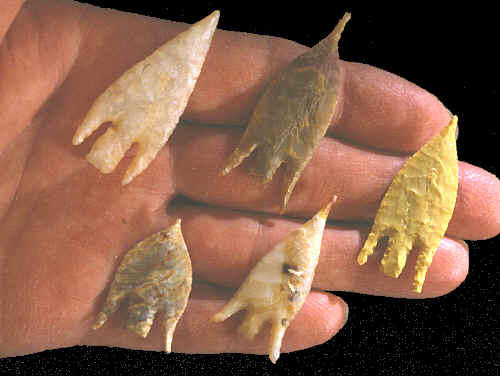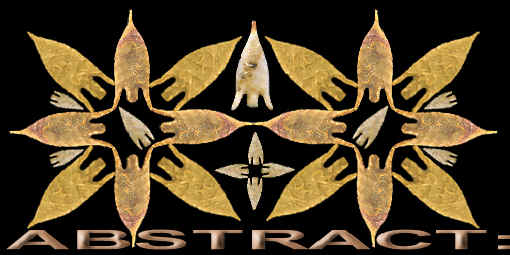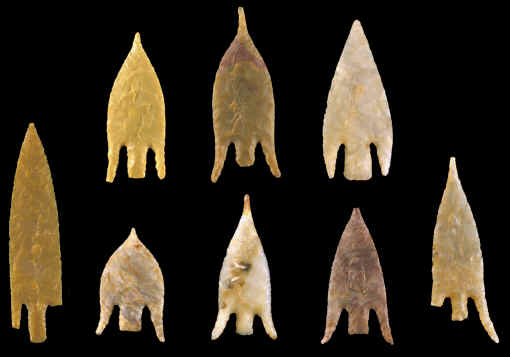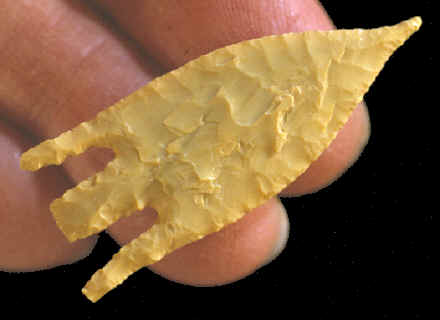|
PAGE
1
FAN EARED
POINTS
NEOLITHIC
PERIOD
SUB-SAHARA,
AFRICA
5,000 B.C.
TO 3,000 B.C.
PAGE 1
OF 2 PAGES
COPYRIGHT
APRIL 30, 2004 PETER A. BOSTROM

FAN
EARED POINTS
SUB-SAHARA, AFRICA
TOM
RICHARDSON COLLECTION |
|
|

|
|
FAN-EARED
POINTS
NEOLITHIC
SUB-SAHARA, AFRICA
Some of the most skillfully made arrow points were made during the
Neolithic period in the
Sub-Sahara region of Africa. This article illustrates and
describes one of the most "exotic" styles that have been
found there. These deeply notched arrowheads with delicate
"ears" and needle points have been appropriately named
Fan-Eared points. |
|
|
"The world which we know would not exist
without fire and the wheel and perhaps the same may hold true of the
bow."---1957,
Edmund Burke, "The History of Archery."
"The Sahara-----was a much more favorable
place to live----than today. Up to about 2000 B.C. the large Ethiopian
game animals abounded and were regularly hunted, as is evidenced by the
many different forms of arrowheads that occur in large numbers at desert
sites."---1971,
J. Desmond Clark, "The Horizon History of Africa," page 31.

CLICK ON
PICTURE FOR LARGE IMAGE
FAN-EARED
POINTS
The Sub-Sahara desert region in Africa has produced a multitude of
different types of stone arrowheads. They are being recovered on sites
in Mali, Burkina Faso, Niger and Chad. One of the most artistic of these
is called a Fan-Eared point. The name is descriptive of the long narrow
barbs they have in varying lengths and angles. Fan-Eared points have
been reported from Mali and Niger.
|
|

CLICK ON
PICTURE FOR LARGE TRIPLE IMAGE
FAN-EARED POINT
NEOLITHIC PERIOD
SUB-SAHARA, AFRICA
TOM RICHARDSON COLLECTION
This Fan-Eared point is a classic example. It has a needle point,
recurved blade edges and deep notches that form long narrow outward
flaring barbs. It's also nicely flaked
on both sides and fairly thin. This point is made of a
beautiful piece of yellow chert of good quality and measures 1 11/16 inches (4.3 cm)
long and 1/8 inch (2.3mm) thick. |
|
|
Petroglyphs in the Sahara desert depict hunters using
bows and arrows dating back thousands of years. The earliest stone arrowheads from this region were made from small trimmed flakes called
microliths. Later examples were made on larger edge-trimmed core blades.
Some of the most artistic examples were flaked on both sides (bifacially
flaked.
|
|
CONTINUE ON TO PAGE
TWO
|
|
"REFERENCES"
1971,
Clark, J. Desmond, "The Horizon History of Africa---African
Beginnings," p. 31.
2003, Overstreet, Robert M., "Indian Arrowheads," pp. 1315-1317.
1957, Burke, Edmund, "The History of Archery"
|
|
HOME
ORDERING |



